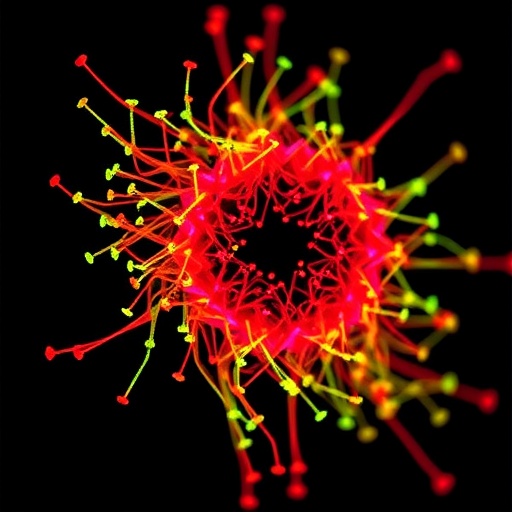In a groundbreaking advancement poised to revolutionize the study of genetic variants in relation to disease, scientists at the European Molecular Biology Laboratory (EMBL) have unveiled a novel technology known as SDR-seq (single-cell DNA-RNA sequencing). This state-of-the-art tool transcends the limitations of current single-cell sequencing methods by enabling simultaneous analysis of both DNA and RNA within the same individual cell. By harnessing this dual-omic capability, SDR-seq allows researchers to intricately link genetic variations—spanning both coding and non-coding regions—to gene expression profiles with unprecedented resolution and throughput.
For decades, the scientific community has recognized hereditary patterns in diseases, an observation tracing back to Hippocrates. Nonetheless, the molecular mechanisms underlying these genetic correlations remained elusive, largely due to technological barriers in capturing the complex relationship between genomic variation and cellular function at a single-cell scale. Traditional single-cell sequencing technologies primarily interrogated either DNA or RNA, rarely both in tandem, and often focused on coding regions where expressed genes reside. This approach, while illuminating certain aspects of gene expression, overlooked the vast expanse of non-coding DNA—the regulatory landscapes where over 95% of disease-associated variants lie.
The SDR-seq platform pioneers a methodological leap by enabling simultaneous reading of genomic DNA and corresponding RNA transcripts in thousands of individual cells simultaneously. Utilizing sophisticated oil-water emulsion droplet microfluidics, each droplet encapsulates a single cell, ensuring that DNA and RNA information remains linked to its cellular origin throughout the processing pipeline. This design exponentially increases throughput and fidelity compared to prior methods, which suffered from limited cell numbers, sensitivity constraints, and technical complexity that impeded broad applicability.
One of the most significant innovations facilitated by SDR-seq is its capacity to detect variants across the entire genome, irrespective of whether they reside within coding exons or within the vast regulatory non-coding expanses. These non-coding regions contain crucial elements like enhancers, silencers, and insulators that orchestrate gene expression patterns fundamental to cellular identity and disease states. Identifying functional consequences of variants in these sections has long been a formidable challenge for genomics researchers, given the paucity of tools capable of capturing both genotype and phenotype from a single cell at sufficient scale.
Dominik Lindenhofer, lead author and postdoctoral scientist at EMBL’s Steinmetz Group, highlights that SDR-seq overcomes these hurdles by “yielding single-cell numbers that enable analysis of complex samples,” thereby providing an unprecedented window into genomic variance that influences cell behavior. Unlike prior approaches limited to expressed (coding) regions, SDR-seq deciphers DNA variants anywhere in the genome, including silent regions, offering a holistic perspective on genomic architecture and its functional outcomes.
The technology’s innovative core further leverages a complex DNA barcoding system that labels both DNA and RNA molecules within each droplet, enabling precise mapping of molecular reads back to individual cells. This system was computationally optimized by Oliver Stegle’s group at EMBL, who developed customized algorithms to decode the intricate barcodes and manage downstream data integration. Their bioinformatics pipeline not only supports SDR-seq but holds promise for diverse applications demanding multiomic single-cell resolution.
Collaborations were instrumental to the refinement and validation of SDR-seq. Teams from Stanford University School of Medicine and Heidelberg University Hospital supplied primary B-cell lymphoma samples characterized by extensive genomic variability. These samples served as rigorous test beds to assess SDR-seq’s sensitivity and its ability to reveal variant-driven alterations in gene expression. The results illuminated compelling connections: lymphoma cells with higher variant burdens exhibited more aggressive transcriptional profiles underlying malignancy, suggesting SDR-seq can unravel mechanistic insights into cancer progression at a level hitherto unattainable.
Furthermore, Lindenhofer explained that the tool elucidates allelic dosage by determining whether variants are present on one or both gene copies within a cell. This granularity allows researchers to quantify the effect of heterozygous versus homozygous mutations on gene expression phenotypes, bridging a critical gap between genotype and cellular function. Such detailed single-cell resolution promises to shed light on disease heterogeneity, cellular plasticity, and therapy resistance mechanisms.
Beyond cancer biology, the implications of SDR-seq extend across biomedical research. Non-coding variant exploration enabled by this technology opens up investigative routes into complex disorders like congenital heart disease, autism, and schizophrenia, where regulatory genetic components have remained enigmatic. By decoding how these variants functionally modulate gene networks within their native genomic contexts, scientists can better understand disease etiology and identify novel molecular targets for intervention.
Lars Steinmetz, senior author and group leader at EMBL as well as professor at Stanford, emphasizes the transformative potential of SDR-seq. He notes that by “linking variants to disease,” the technology “opens up a wide range of biology that we can now discover.” This capability is poised to fundamentally shift how genetic information is used to inform diagnostics, prognostics, and treatment strategies, promising improved precision medicine approaches for a myriad of conditions.
The seamless integration of microfluidic engineering, molecular biology, and computational innovation embodied in SDR-seq exemplifies the power of interdisciplinary collaboration in modern genomics. It sets a new standard for scale, precision, and sensitivity in single-cell multiomic profiling, making it an indispensable tool for scientists aiming to decode the complex interplay between genome and transcriptome within individual cells.
As SDR-seq technology continues to mature, it is anticipated to catalyze new research frontiers in developmental biology, immunology, oncology, and beyond. Its ability to directly couple genomic identity with transcriptional output in thousands of cells simultaneously paves the way for comprehensive cellular atlases that capture the nuances of health and disease at single-cell resolution.
The scientific community eagerly awaits broader deployment of SDR-seq, alongside further methodological refinements and computational advancements, which collectively will accelerate discoveries into the functional genomic variants shaping human biology. This powerful new lens on the genome promises not only deeper understanding, but also tangible improvements in diagnostics and therapeutic intervention for complex diseases, marking a new era in precision genomics.
Subject of Research: Cells
Article Title: Functional phenotyping of genomic variants using multiomic scDNA-scRNA-seq
News Publication Date: 1-Sep-2025
Web References: 10.1038/s41592-025-02805-0
Image Credits: Daniela Velasco/EMBL
Keywords: Molecular biology, Molecular genetics




